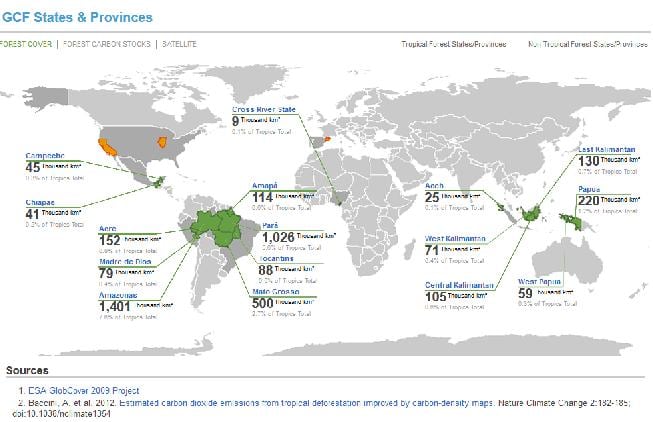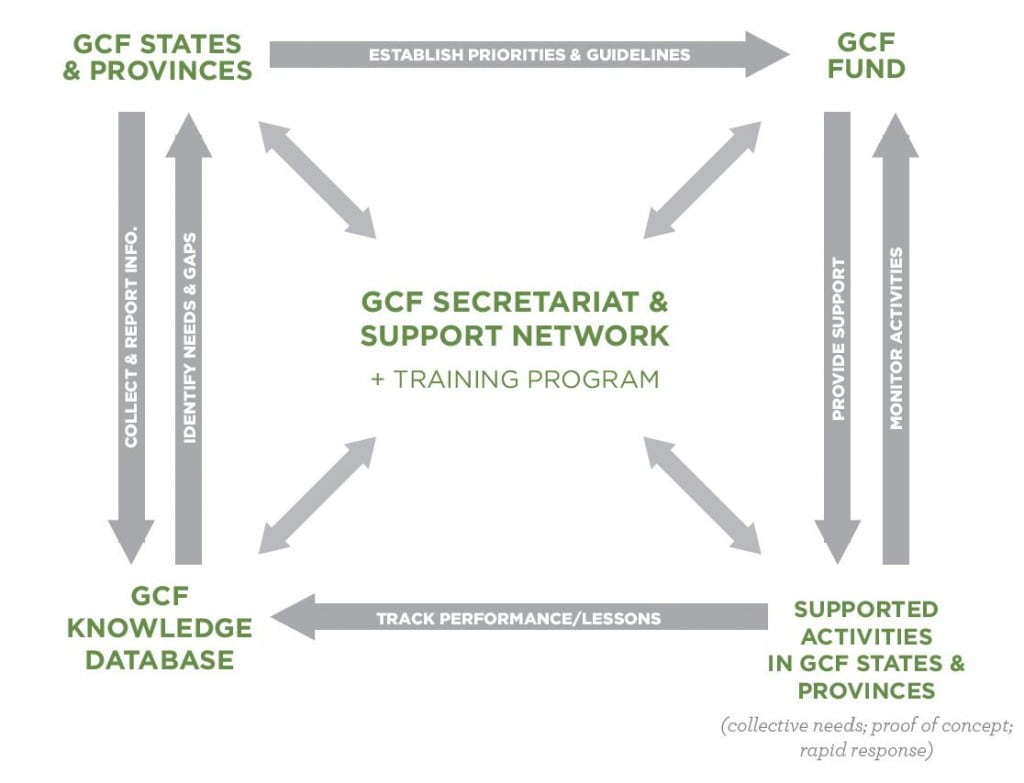 There’s a gap in our conversation on climate change: connecting it to all areas of our quality of life and focusing on ways in which climate change mitigation can also work to alleviate poverty. William Boyd, Senior Advisor and Project Lead for the Governors’ Climate and Forests Task Force (GCF) and Amelia Petersen, Senior Research Fellow, offer firsthand insight into a unique subnational collaboration that is engaging a network of actors from government, civil society, academia, and the private sector to build climate protection into durable frameworks for forest protection and improved rural livelihoods. Be sure to visit http://www.gcftaskforce.org/ – plenty of great info and explanatory graphics. … The Governors’ Climate & Forests Task Force (GCF) consists of 22 states and provinces from 7 countries working to protect tropical forests, reduce emissions from deforestation and forest degradation, and promote realistic pathways to forest-maintaining rural development. (Click image for full size)
There’s a gap in our conversation on climate change: connecting it to all areas of our quality of life and focusing on ways in which climate change mitigation can also work to alleviate poverty. William Boyd, Senior Advisor and Project Lead for the Governors’ Climate and Forests Task Force (GCF) and Amelia Petersen, Senior Research Fellow, offer firsthand insight into a unique subnational collaboration that is engaging a network of actors from government, civil society, academia, and the private sector to build climate protection into durable frameworks for forest protection and improved rural livelihoods. Be sure to visit http://www.gcftaskforce.org/ – plenty of great info and explanatory graphics. … The Governors’ Climate & Forests Task Force (GCF) consists of 22 states and provinces from 7 countries working to protect tropical forests, reduce emissions from deforestation and forest degradation, and promote realistic pathways to forest-maintaining rural development. (Click image for full size)  The GCF was launched to respond directly to the fundamental problems of tropical deforestation and climate change, and the related problems of ecological disruption, biodiversity loss, food/energy/water insecurity, and rural poverty. The overarching rationale of the GCF is that any successful effort to address the complex relationship between forests, land use, and climate change requires multiple efforts at multiple levels of governance, and that state and provincial governments, together with their civil society partners, are among the most important actors in building viable programs for low emissions rural development. The GCF was therefore conceived as an effort to leverage the fact that certain states and provinces around the world are in a position to be early movers in the effort to build robust jurisdictional programs for REDD+ and low emissions development, thereby bolstering overall momentum for the issue and enhancing national and international efforts to demonstrate how this can work in practice.
The GCF was launched to respond directly to the fundamental problems of tropical deforestation and climate change, and the related problems of ecological disruption, biodiversity loss, food/energy/water insecurity, and rural poverty. The overarching rationale of the GCF is that any successful effort to address the complex relationship between forests, land use, and climate change requires multiple efforts at multiple levels of governance, and that state and provincial governments, together with their civil society partners, are among the most important actors in building viable programs for low emissions rural development. The GCF was therefore conceived as an effort to leverage the fact that certain states and provinces around the world are in a position to be early movers in the effort to build robust jurisdictional programs for REDD+ and low emissions development, thereby bolstering overall momentum for the issue and enhancing national and international efforts to demonstrate how this can work in practice.
A key component of this work is a common database that compiles and tracks key activities and program development among GCF members: The GCF Knowledge Database was launched at the UN Conference on Sustainable Development (Rio+20) in June 2012.
The database provides an open, web-based source of information from individual GCF member states and provinces on current status and trends regarding land use and deforestation; forest carbon accounting efforts and methodologies; jurisdictional program development and implementation activities; and related financial flows. The database is updated on a regular basis, and seeks to be fully transparent with respect to all sources of information. It is intended to serve not only the GCF states and provinces, but also their civil society partners, potential investors, and other interested stakeholders. The database is available at www.gcftaskforce-database.org We’re thankful to William Boyd and Amelia Petersen for taking time to sit with us for this Q&A. What is the origin of the GCF Knowledge Database? The GCF Knowledge Database grew out of a needs assessment initiated in 2009 by the GCF member states and provinces. The tool was initially directed at providing key information on REDD+ program development for policy-makers but has evolved to capture the broader elements of jurisdictional programs for low emissions development. In its enhanced form, the database now serves as tool for knowledge management and sharing across the GCF’s 22 jurisdictions. Its publicly accessible platform and performance-tracking features drive improved transparency, providing the knowledge foundation for the development of high-quality jurisdictional programs. GCF members and partners across the world helped to collect information for the first iteration of the Database and continue to update it annually. The Database has been made possible by generous support from the Gordon & Betty Moore Foundation, the ClimateWorks Foundation, and the Climate & Land Use Alliance. Through a grant from the Norwegian Agency for Development Cooperation (Norad), in 2013 the GCF launched an a complementary effort—the GCF Support Network—that will map the network of key actors and activities in individual jurisdictions and provide rapid access to both the local network of relevant actors in each GCF state or province, and to the larger network of resources across the world. How would you describe its ideal use and how it can inform action? The database functions as a real-time asset. It is designed to continuously capture data on the key components of jurisdictional program development and performance in GCF jurisdictions as conditions change on the ground. How is the database structured? The GCF Knowledge Database is organized by country for national-level information and by state or province for subnational information. For each state or province, information is organized into four main categories: forest carbon accounting, governance and implementation, financing, and audits and reviews. How are the members of the collaboration using the database? More than 20% of the world’s tropical forests are in GCF states and provinces, including approximately 75% of Brazil’s and more than half of Indonesia’s tropical forests. Over 500 REDD+ stakeholders are already actively engaging with the data available in the database. The database has generated participation and interest from people working on various aspects of deforestation reduction and low-emissions development programs including heads of government, civil servants, local and international groups, and community liaisons in Indonesia, Ecuador, Japan, Brazil, Malaysia, Mexico, the United Kingdom, Spain, Norway, the U.S., and Nigeria, to mention just a few. Beginning in 2014, the GCF Database will also track activities supported through the GCF Fund. This initiative is an important model for transparent, rapid deployment of climate finance that supports policy innovation at the subnational level. The Database will track and report on the GCF Fund-supported activities, and will continue to identify needs and gaps through both the Knowledge Database updating effort and other GCF activities that can serve as a basis for determining strategic objectives for the GCF Fund. See figure below  What are your on-going challenges? The GCF continues to address both internal and external challenges. Internally, we’ve noticed that many jurisdictions still lack the capacity (staff) for ongoing collection and updating of data. We would also like for future versions of the database to include the primary languages spoken in GCF jurisdictions, particularly Spanish, Portuguese, and Indonesian. Externally, there is a continual need for access to high-quality information, for example on financing for projects and programmatic support.
What are your on-going challenges? The GCF continues to address both internal and external challenges. Internally, we’ve noticed that many jurisdictions still lack the capacity (staff) for ongoing collection and updating of data. We would also like for future versions of the database to include the primary languages spoken in GCF jurisdictions, particularly Spanish, Portuguese, and Indonesian. Externally, there is a continual need for access to high-quality information, for example on financing for projects and programmatic support.
